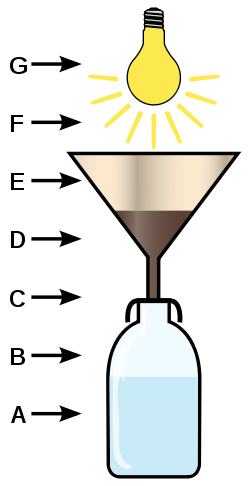A
Tullgren funnel, also known as
Berlese funnel or
Berlese trap, is an apparatus used to extract living organisms, particularly arthropods, from samples of soil. The Tullgren funnel works by creating a temperature gradient over the sample such that mobile organisms will move away from the warmer temperatures and fall into a collecting vessel, where they perish and are preserved for examination. The illustration shows how it works: a funnel (E) contains the soil or litter (D), and a heat source (F) such as an electric lamp (G) heats the litter. Animals escaping from the desiccation of the litter descend through a filter into a preservative liquid (A) in a receptacle (B). This illustration is mere schematical, since usually the soil sample will not be crumbled and poured into the funnel (this would inevitably lead to a high amount of soil particles in the preservation fluid requiring laborious work to sort out the soil organisms). In fact, the soil sample is placed on a mesh sieve that will allow the soil animals to pass but should retain most of the soil particles.
This type of extraction is commonly referred to as Berlese funnel or Tullgren funnel. Antonio Berlese described this method of dynamic sampling in 1905 with a hot water jacket as heat source. In 1918 Albert Tullgren described a modification, where the heating came from above by an electric bulb and the heat gradient was increased by an iron sheet drum around the soil sample. Today's extraction funnels of this type usually combine elements from both publications and thus should be referred to as Berlese-Tullgren funnel.
The source of this article is
wikipedia, the free encyclopedia. The text of this article is licensed under the
GFDL.



